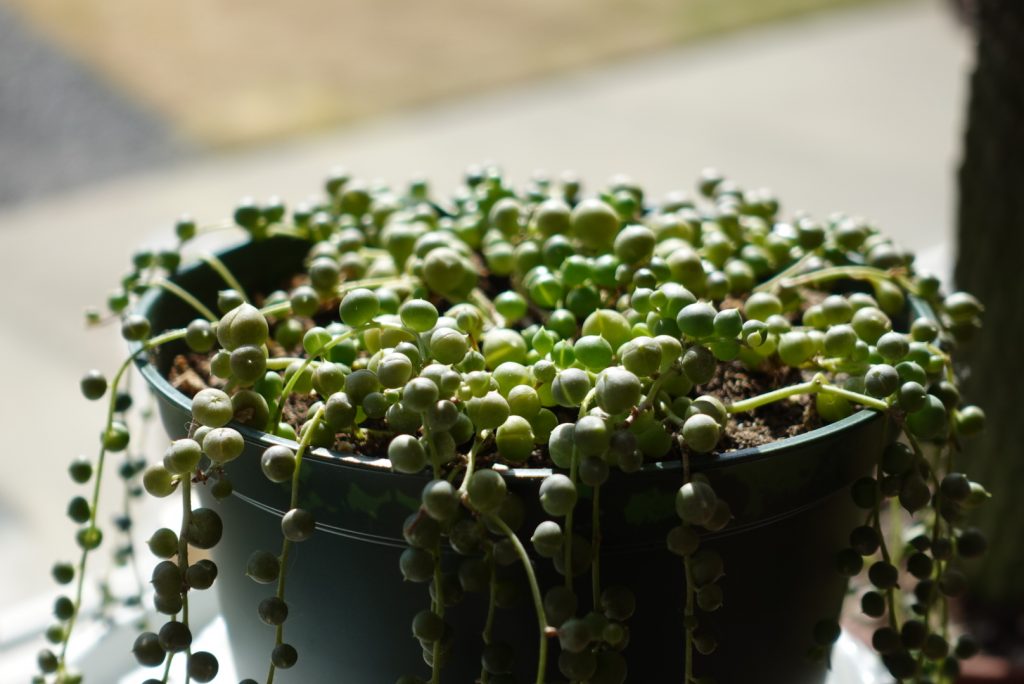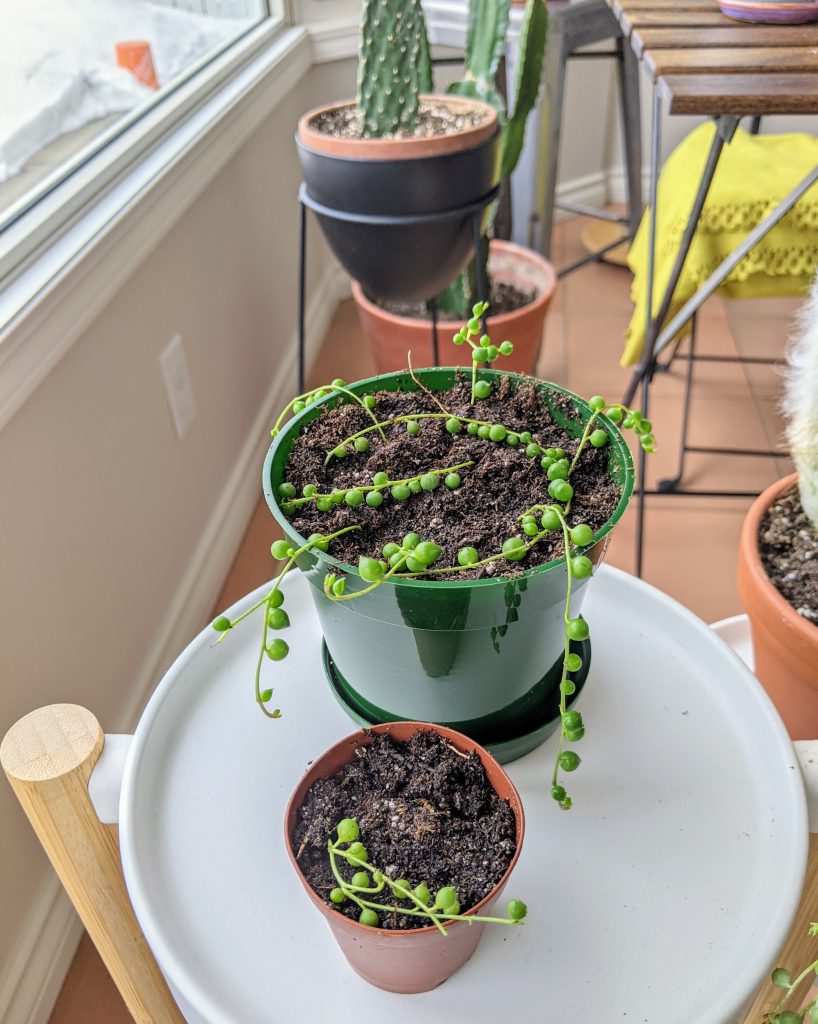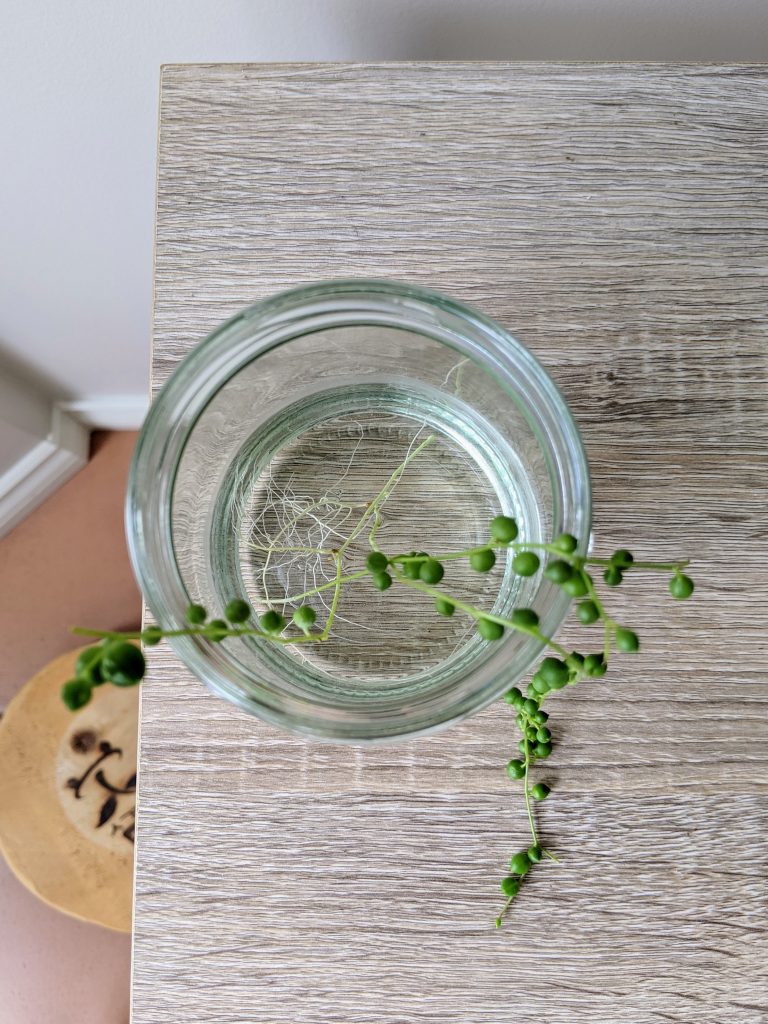String of pearls is my favorite succulent, and also one of my favorite plants in general.
Caring for them has been lots of trial and error, but I think I’ve finally cracked the code. They’re such an elegant plant that deserves to be shown off.
I love them so much, I’ve even compiled a list of cute names for this plant and other succulents and cacti.
At the greenhouse, it’s hard to resist the young and adorable babies with their perfectly shaped pearls.
Many people bring them home and quickly learn that they’re not the easiest to take care of. I’ve found they require a lot more balance than other plants.
After all my years of experimenting with this plant, I’ve found the perfect formula which you can find in this guide to caring for your string of pearls (senecio rowleyanus).
This post contains affiliate links, which means I may make a small commission if you click through and make a purchase.
How to Know if Your String of Pearls is Healthy or Not
Here’s a quick lesson to determine what shape your plant is in and whether you need to worry.
A healthy and thriving plant will have firm, plump and consistent pearls that are a decent size.
They should look almost like small marbles and should be bright and glossy.

The windows should be easily visible (this is the thin clear line down the center of the pearl). The pearls should be relatively uniform and consistent on the strand.
A dehydrated string of pearls (or one that’s receiving too much sun) will have pearls that look more oval shaped.
They will be more pointed instead of round and more dull in color and somewhat squishy to the touch.
An overwatered string of pearls will exert pearls that are mushy and oddly shaped. Sometimes they will also be darker in color.
Light Requirements

Your string of pearls needs several hours of bright, indirect sunlight every day.
They don’t need or like direct sunlight; so if you have them in front of a south or west facing window, I would move them away by at least 10 or 12 feet.
You can also supplement with a grow light in the winter months, but it likely won’t be able to survive from a grow light alone.
Make sure the Light is Evenly Distributed
Placement is also key. Your string of pearls needs light hitting both the top of the plant and the strands that cascade down.
The little striped windows on each pearl is actually how it absorbs light.
One mistake I made in my early years of owning string of pearls was placing in a macrame hanger. The light didn’t reach the top of the plant well enough, and when I moved it lower to the ground, it began to thrive.
String of pearls are also very susceptible to sunburn and get scorched quite easily. Avoid hot afternoon sun.
You’ll know it’s getting too much heat if the pearls start to turn purple and change shape to be no longer round. The stands will also start to look more scraggly looking.
Read more about providing the right amount of light for your succulents.
How Often to Water String of Pearls

Figuring out the right amount of water for your string of pearls will be one of the top reasons for success or failure.
Only water your string of pearls when the soil is completely dry. It’s a succulent and can thrive with little watering for a long time.
Unfortunately you can’t really water this plant on a schedule, it will tell you when it needs water.
When your finger feels dry at least two inches down in the soil, you can probably water it. But if you’re not sure, always wait a few more days.
Cut back on the watering in the cooler winter months when it doesn’t get as much sun.
For reference, in the growing season, I usually water once every 10-14 days, and in winter, once a month or less.
Water Completely Through
When you do water, make sure there’s plenty of it. Until water is running through the bottom for a few minutes.
They prefer a good drench on occasion instead of small sips here and there.
If your string of pearls is in a shallow pot, you will probably have success with bottom watering.
This is when you place the pot in a dish of water a few inches high so it can absorb water through the bottom of the roots.
Be careful with this though, as string of pearls have very shallow roots. So if they’re planted in a pot that deeper than 5 inches, bottom watering might not work.
Avoid Misting
Do not mist your string of pearls, especially as a replacement for watering.
They don’t need the extra humidity and keeping the soil moist is not healthy for this type of plant.
The only time you should mist your string of pearls is for the first few days of soil propagation.
Soil, Repotting & Type of Pot

First, don’t rush to repot your string of pearls if you’ve just brought it home from the greenhouse. Since the root system is so shallow, they can stay in their nursery pots for some time.
When you do eventually re-pot, make sure the pot isn’t too big – it should only be about an inch or two bigger than what it’s currently living in. This is because a pot that’s too big has more soil; it will hold onto to water for too long.
This will likely lead to root rot.
Always use a soil mix that’s specific to succulents and cacti. You can find mixes at most garden centers or even on Amazon.
This type of soil is designed to be gritty and well-draining for lots of aeration.
No matter what soil mix you choose, I already recommend adding in a little more perlite for extra drainage.
You can never go wrong with more drainage and I find the pre-mixed soils don’t have quite enough perlite.
It helps distribute water throughout the soil.

I’ve found the type of pot doesn’t really matter for string of pearls – as long as it’s the right size an has drainage holes in the bottom.
I would choose terracotta, clay or plastic though. Stay away from glass or metal pots as these would just get too hot.
You can read more about choosing the right type of pot for your succulents and cacti.
Getting Your String of Pearls to Grow (Fuller)

When the strands of your string of pearls start to get long enough to trail over the edge of your pot, this is when it gets exciting!
Over time though, you might notice that the strands just continue to get long and that the top of the plant appears to thin out a bit.
To make your string of pearls grow fuller, snip off 4-6 inches from the bottom of the long strands and replant them in the soil of your mother plant.
When you replant the strands, make sure that at least one or two nodes are planted in the soil, as this is where roots will form.
Growing String of Pearls
The only real secret to making your string of pearls grow faster is by providing it with optimal growing conditions (as outlined above) and to use fertilizer in the growing months.
Every two weeks I use a small amount of succulent & cacti fertilizer.
In the winter, once a month I use a diluted mix of Marphyl soil enhancer, which is marine phytoplankton.
How to Propagate String of Pearls
Soil Propagation Method


3 months growth
Even though they’re not the easiest plant to keep alive, propagating string of pearls is quite simple.
The easiest method is to snip off a strand a few inches long, and lay it down on soil. Make sure there are at least 2 or 3 nodes, and try to lay them facing down into the soil. After a few weeks it will start to reach further into the soil and develop roots.
You can also poke a hole in the soil and place a strand (with at least 2 nodes) in it, with the rest of the strand trailing down the pot.
When I’m propagating string of pearls, I usually place multiple strands in one small pot and use both methods.
When you propagate this way, allow the cutting to dry out for a couple of days first before planting it.
When you soil propagate string of pearls, you should start to see some significant growth after about 3-4 months.
Propagation in Water

Propagating string of pearls is also quite simple. Take a few cuttings and suspend them in a jar of water.
Make sure the pearls aren’t sitting in water though – you might have to pull off a few pearls at the top of the cutting.
Roots will grow in the water over the next few months. The last time I water propagated string of pearls, the roots took about 3.5 months to grow until they were ready to be potted in soil.
When the roots are plentiful and several inches long, you can carefully plant them in soil.
Since the roots have been used to growing in water, you’ll want to keep the soil relatively moist for the first few weeks (not soggy).

Keep in mind that you cannot grow a full strand or entire string of pearls plant from a single pearl. You need nodes for propagation.
The node looks like a joint in the stem and usually has a small brown bump coming out of it, which is the aerial root.
Problems With String of Pearls
If you’re string of pearls is just not loving life, it’s likely due to over-watering or improper lighting.
These plants do not like too much water, as they are very drought resistant.
If you think they’ve been moist or soggy for too long, you can try to gently pull the plant out of it’s pot and let the roots dry out for a few days.
If it’s not getting enough light, it won’t grow nearly as fast and is more susceptible to the destruction of overwatering.
Too much light will also cause sunburn and it’s hard to recover from that.
View my full troubleshooting guide on why your string of pearls is dying and easy fixes.
Visit my Houseplant Toolbox for a list of all my favorite supplies & goodies!

Bloom On!
I hope this guide has inspired some confidence in your string of pearls growing skills. If there’s anything I didn’t cover, please let me know in the comments below!


what is the best soil to use for Sting of Pearls
Hi Lorie, there are lots of great pre-mixed succulent & cacti soils you can buy. Just don’t buy Miracle Gro brand! As long as it says it is fast-draining and contains sand and perlite, this will be a good choice. If you scroll up in the post under the heading ‘soil’, I provided a link to Amazon which has succulent soils for purchase 🙂
Have a string of pearls that has three long tendrils that are growing like crazy! But that is the entire plant. There is nothing else growing IN the pot. Should I pull a tendril into the pot? Will it root in? Should I cut one tendril and root it in water?
If there’s nothing else happening in the pot, I would cut the tendrils, root them in water and start a fresh plant.